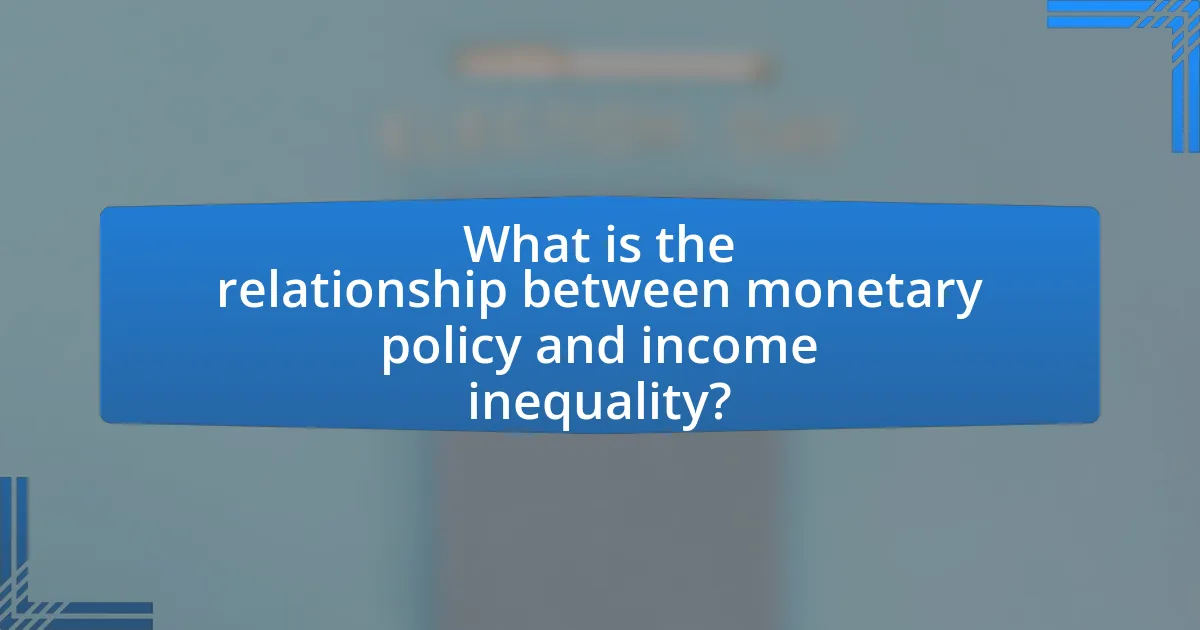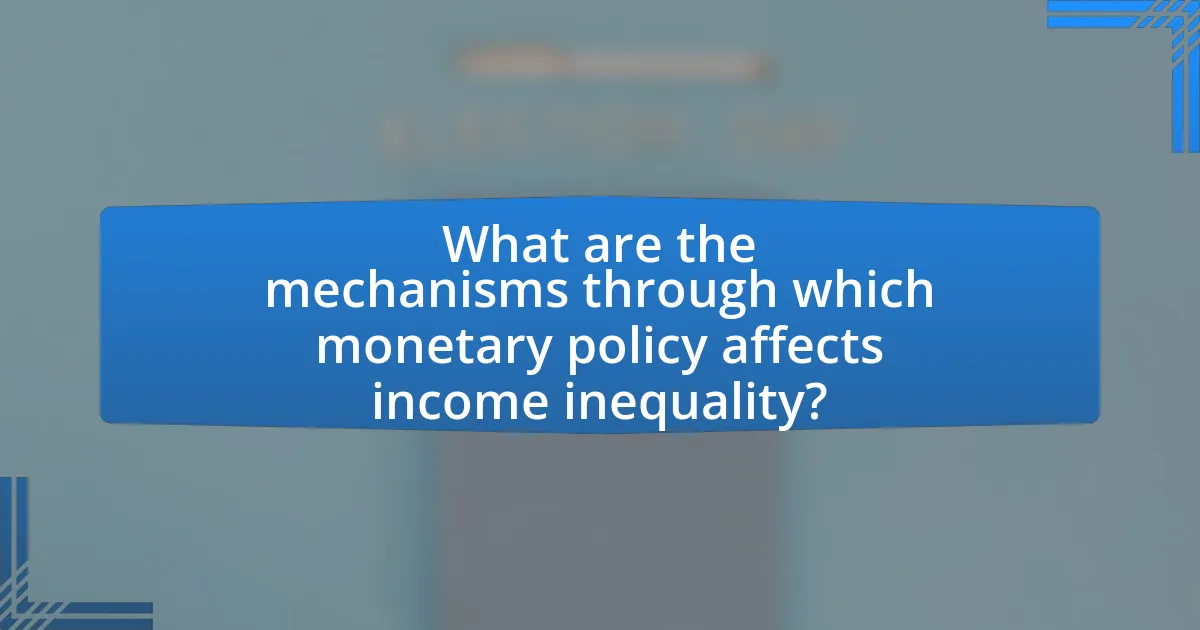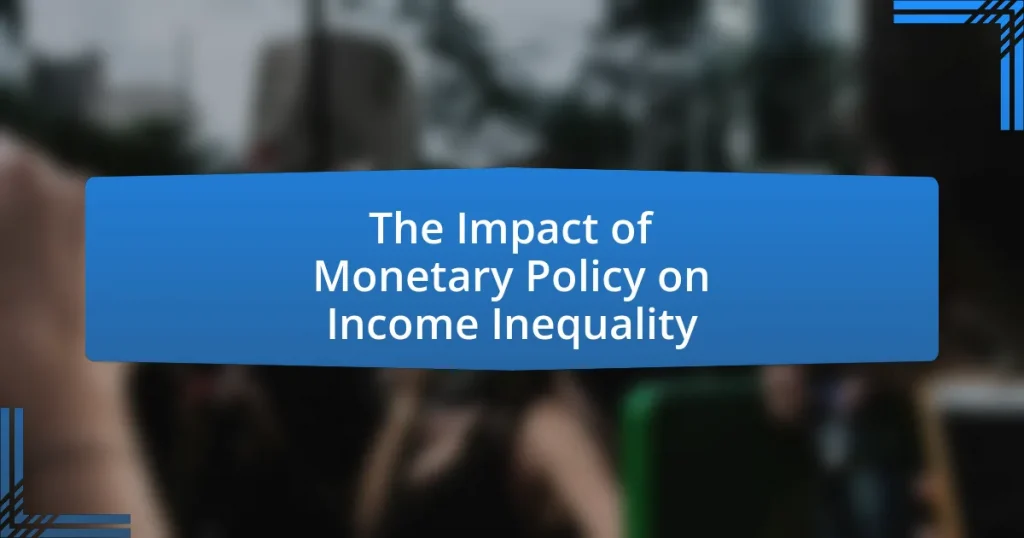The article examines the relationship between monetary policy and income inequality, highlighting how central bank actions, such as interest rate adjustments and quantitative easing, disproportionately benefit wealthier individuals by inflating asset prices. It discusses the mechanisms through which monetary policy influences economic conditions and wealth distribution, emphasizing the impact on different income groups. Additionally, the article explores the long-term implications of these policies on economic growth and wealth disparity, while proposing potential solutions, including progressive taxation and targeted government spending, to mitigate the adverse effects of monetary policy on income inequality.

What is the relationship between monetary policy and income inequality?
Monetary policy significantly influences income inequality by affecting asset prices and interest rates, which disproportionately benefit wealthier individuals. When central banks implement expansionary monetary policies, such as lowering interest rates or engaging in quantitative easing, they tend to increase the value of financial assets like stocks and real estate. According to a study by the International Monetary Fund, these policies can exacerbate income inequality as wealthier households are more likely to own such assets, leading to greater wealth accumulation compared to lower-income households who primarily rely on wages. Thus, the relationship between monetary policy and income inequality is characterized by the differential impact of policy measures on various income groups, often widening the gap between the rich and the poor.
How does monetary policy influence economic conditions?
Monetary policy influences economic conditions primarily through interest rates and money supply management. By adjusting interest rates, central banks can either encourage borrowing and spending during economic downturns or curb inflation by making borrowing more expensive when the economy is overheating. For instance, the Federal Reserve lowered interest rates to near-zero levels during the 2008 financial crisis to stimulate economic activity, which resulted in increased consumer spending and investment. Conversely, raising interest rates can slow down economic growth by reducing consumer and business spending, as seen in the Fed’s actions in the late 1970s to combat high inflation. These adjustments directly impact inflation rates, employment levels, and overall economic growth, demonstrating the critical role of monetary policy in shaping economic conditions.
What are the key tools of monetary policy?
The key tools of monetary policy are open market operations, the discount rate, and reserve requirements. Open market operations involve the buying and selling of government securities to influence the money supply and interest rates. The discount rate is the interest rate charged to commercial banks for loans obtained from the central bank, which affects lending rates throughout the economy. Reserve requirements dictate the minimum reserves each bank must hold against deposits, directly impacting the amount of money banks can lend. These tools are essential for central banks to manage economic stability and influence income distribution through monetary policy.
How do these tools impact different income groups?
Monetary policy tools, such as interest rate adjustments and quantitative easing, impact different income groups by influencing access to credit and asset prices. Lower interest rates typically benefit lower-income groups by making borrowing cheaper, which can stimulate spending and investment. Conversely, higher-income groups often benefit more from asset price inflation resulting from quantitative easing, as they are more likely to own stocks and real estate. Research indicates that during periods of expansive monetary policy, wealth inequality tends to increase, as the affluent see greater gains in asset values compared to lower-income individuals, who may not have significant investments. This dynamic reinforces existing disparities, as evidenced by studies showing that the top 10% of earners have disproportionately benefited from asset price increases compared to the bottom 50% of earners.
Why is income inequality a significant issue in economic discussions?
Income inequality is a significant issue in economic discussions because it affects overall economic stability and growth. High levels of income inequality can lead to reduced consumer spending, as wealthier individuals tend to save more of their income compared to lower-income households, which spend a larger proportion of their earnings. According to a study by the International Monetary Fund, countries with higher income inequality experience slower economic growth, as the concentration of wealth limits opportunities for lower-income individuals to invest in education and entrepreneurship. This dynamic creates a cycle where income inequality perpetuates itself, hindering social mobility and exacerbating economic disparities.
What are the main causes of income inequality?
The main causes of income inequality include differences in education, labor market dynamics, technological advancements, globalization, and tax policies. Education disparities lead to varying skill levels, affecting job opportunities and wages; for instance, individuals with higher education typically earn significantly more than those without. Labor market dynamics, such as the decline of manufacturing jobs and the rise of service-oriented jobs, contribute to wage stagnation for lower-skilled workers. Technological advancements often favor skilled workers, creating a wage gap as automation replaces lower-skilled jobs. Globalization can exacerbate income inequality by shifting jobs to lower-wage countries, impacting domestic employment. Lastly, tax policies that favor the wealthy can widen the income gap, as seen in the United States where tax cuts for high-income earners have been linked to increased income inequality.
How does income inequality affect economic growth?
Income inequality negatively affects economic growth by limiting access to resources and opportunities for lower-income individuals, which in turn reduces overall productivity and consumption. When wealth is concentrated in the hands of a few, the majority of the population may lack the financial means to invest in education, health, and entrepreneurship, leading to a less skilled workforce and lower innovation rates. Research by the International Monetary Fund indicates that countries with higher income inequality tend to experience slower economic growth, as evidenced by a study showing that a 1% increase in income inequality can reduce GDP growth by approximately 0.08% to 0.12% annually. This correlation highlights the detrimental impact of income disparity on the broader economy.

What are the mechanisms through which monetary policy affects income inequality?
Monetary policy affects income inequality primarily through interest rate adjustments, asset price inflation, and credit availability. When central banks lower interest rates, borrowing becomes cheaper, which can disproportionately benefit wealthier individuals and corporations who have access to credit, leading to greater asset accumulation. For instance, lower rates often result in rising stock and real estate prices, which primarily benefit those who already own such assets, exacerbating wealth disparities. Additionally, monetary policy can influence employment levels; expansionary policies may reduce unemployment, but the benefits may not be evenly distributed across income groups, often favoring higher-skilled workers. Research by the International Monetary Fund indicates that prolonged low interest rates can lead to increased income inequality, as the wealth generated from asset appreciation is not evenly shared among all socioeconomic groups.
How do interest rates impact wealth distribution?
Interest rates significantly impact wealth distribution by influencing borrowing costs and investment returns. Lower interest rates typically benefit borrowers, allowing them to access credit more easily, which can lead to increased spending and investment. This can disproportionately benefit wealthier individuals who have more access to capital and investment opportunities. Conversely, higher interest rates increase borrowing costs, which can hinder economic growth and disproportionately affect lower-income individuals who may rely on credit for essential purchases. Research from the International Monetary Fund indicates that prolonged low interest rates can exacerbate income inequality by inflating asset prices, primarily benefiting those who already own assets, thus widening the wealth gap.
What is the effect of low interest rates on asset prices?
Low interest rates generally lead to higher asset prices. This occurs because lower borrowing costs make it cheaper for individuals and businesses to finance investments, increasing demand for assets such as stocks and real estate. For instance, a study by the Federal Reserve Bank of San Francisco found that a 1% decrease in interest rates can lead to a 10% increase in stock prices. Additionally, low interest rates encourage investors to seek higher returns in riskier assets, further driving up prices in those markets.
How do high interest rates affect borrowing and spending among different income groups?
High interest rates reduce borrowing and spending, with varying impacts across different income groups. Lower-income households often rely on credit for essential purchases and may face significant financial strain as borrowing costs increase, leading to reduced consumption. In contrast, higher-income groups typically have more access to savings and alternative financing options, allowing them to maintain spending levels despite higher interest rates. For instance, a study by the Federal Reserve found that lower-income families are more sensitive to interest rate changes, as they allocate a larger portion of their income to debt repayment compared to wealthier households. This disparity exacerbates income inequality, as high interest rates disproportionately hinder the financial mobility of lower-income individuals while allowing wealthier individuals to navigate the economic landscape more effectively.
In what ways does quantitative easing influence income inequality?
Quantitative easing influences income inequality primarily by increasing asset prices, which disproportionately benefits wealthier individuals who hold financial assets. As central banks purchase government bonds and other securities, the increased demand raises their prices, leading to lower interest rates and encouraging investment in equities and real estate. This results in a wealth effect, where asset holders experience significant gains, while those without assets, typically lower-income households, do not benefit similarly.
Research from the Federal Reserve indicates that the wealthiest 10% of households own approximately 70% of financial assets, meaning that the benefits of rising asset prices are concentrated among the affluent. Furthermore, quantitative easing can lead to higher inflation, which affects lower-income individuals more severely as they spend a larger portion of their income on necessities. Thus, while quantitative easing aims to stimulate the economy, it can exacerbate existing income disparities by favoring those with existing wealth and assets.
How does quantitative easing affect employment rates across income levels?
Quantitative easing (QE) generally increases employment rates across various income levels by stimulating economic activity. When central banks implement QE, they lower interest rates and increase the money supply, which encourages borrowing and investment. This influx of capital can lead to job creation in sectors that employ individuals across different income brackets. For instance, a study by the Federal Reserve Bank of San Francisco found that QE contributed to a significant reduction in unemployment rates, particularly benefiting lower-income workers who are often more sensitive to economic fluctuations. Additionally, research from the Brookings Institution indicates that the positive effects of QE on employment are more pronounced in lower-income communities, as these areas tend to experience higher job growth in response to increased economic activity.
What are the long-term implications of quantitative easing on wealth disparity?
Quantitative easing (QE) tends to exacerbate wealth disparity over the long term. This occurs because QE primarily benefits asset holders, such as wealthy individuals and corporations, by increasing the value of financial assets like stocks and real estate. For instance, a study by the Federal Reserve Bank of New York found that the top 10% of households own 84% of all stocks, meaning that the wealth generated through rising asset prices disproportionately enriches this group. Additionally, lower interest rates resulting from QE can lead to increased borrowing and investment, but those without significant assets or credit access, often lower-income households, do not benefit similarly. Consequently, the gap between the wealthy and the poor widens, as the affluent accumulate more wealth while the less affluent struggle to gain financial stability.

What are the potential solutions to mitigate the impact of monetary policy on income inequality?
Potential solutions to mitigate the impact of monetary policy on income inequality include implementing progressive taxation, enhancing social safety nets, and promoting inclusive economic growth. Progressive taxation can redistribute wealth more equitably by taxing higher incomes at increased rates, thereby funding public services that benefit lower-income households. Enhancing social safety nets, such as unemployment benefits and food assistance programs, can provide crucial support during economic downturns, reducing the adverse effects of monetary policy on vulnerable populations. Additionally, promoting inclusive economic growth through investments in education and job training can empower lower-income individuals, enabling them to participate more fully in the economy and benefit from monetary policy measures. These approaches are supported by research indicating that targeted fiscal policies can effectively counteract the regressive effects of monetary policy on income distribution.
How can fiscal policy complement monetary policy to address income inequality?
Fiscal policy can complement monetary policy to address income inequality by implementing targeted government spending and progressive taxation. Targeted government spending, such as investments in education and healthcare, can enhance opportunities for lower-income individuals, thereby reducing disparities. Progressive taxation ensures that higher-income earners contribute a fairer share, redistributing wealth and funding social programs that benefit disadvantaged groups. Historical data shows that countries with robust fiscal policies, like the Nordic nations, have successfully reduced income inequality while maintaining economic growth, demonstrating the effectiveness of this complementary approach.
What role do tax policies play in reducing income inequality?
Tax policies play a crucial role in reducing income inequality by redistributing wealth through progressive taxation and social welfare programs. Progressive tax systems impose higher tax rates on higher income brackets, which helps to decrease the income gap between the wealthy and lower-income individuals. For instance, in the United States, the top marginal tax rate was as high as 94% during the 1940s, contributing to a significant reduction in income inequality during that period. Additionally, tax revenues are often allocated to social programs that support low-income families, such as food assistance and healthcare, further alleviating poverty and promoting economic equity. Studies have shown that countries with more progressive tax systems, like Sweden and Denmark, exhibit lower levels of income inequality compared to those with regressive tax structures.
How can government spending be directed to support lower-income groups?
Government spending can be directed to support lower-income groups through targeted social programs, tax credits, and direct financial assistance. For instance, implementing or expanding programs like the Earned Income Tax Credit (EITC) has been shown to lift millions of families out of poverty, with the U.S. Department of the Treasury reporting that the EITC lifted approximately 5.6 million people above the poverty line in 2019. Additionally, increasing funding for affordable housing initiatives can provide lower-income families with stable living conditions, which is crucial for economic mobility. Research from the National Low Income Housing Coalition indicates that every $1 invested in affordable housing generates $1.50 in economic returns, demonstrating the effectiveness of such spending. Furthermore, investing in education and job training programs can enhance the skills of lower-income individuals, leading to better employment opportunities and higher wages, as evidenced by studies from the Brookings Institution showing that vocational training can increase earnings by up to 20%.
What best practices can policymakers adopt to balance monetary policy and income equality?
Policymakers can adopt progressive taxation and targeted social spending as best practices to balance monetary policy and income equality. Progressive taxation ensures that higher income brackets contribute a larger percentage of their income, which can then be redistributed through social programs aimed at low- and middle-income households. For instance, research from the International Monetary Fund indicates that countries with more progressive tax systems tend to have lower income inequality levels. Additionally, targeted social spending on education, healthcare, and housing can help reduce disparities by providing essential services to disadvantaged groups, thereby promoting equal opportunities. This approach aligns monetary policy with social equity goals, as evidenced by studies showing that inclusive growth strategies can enhance overall economic stability and resilience.


